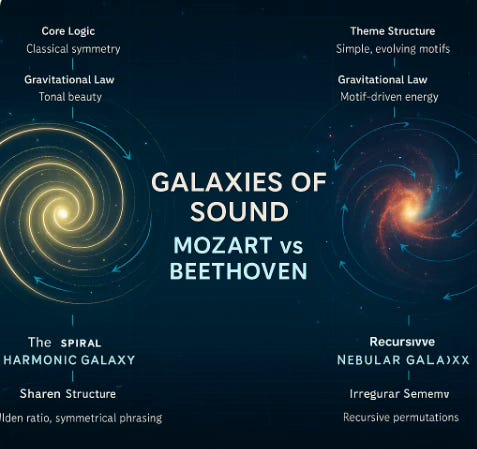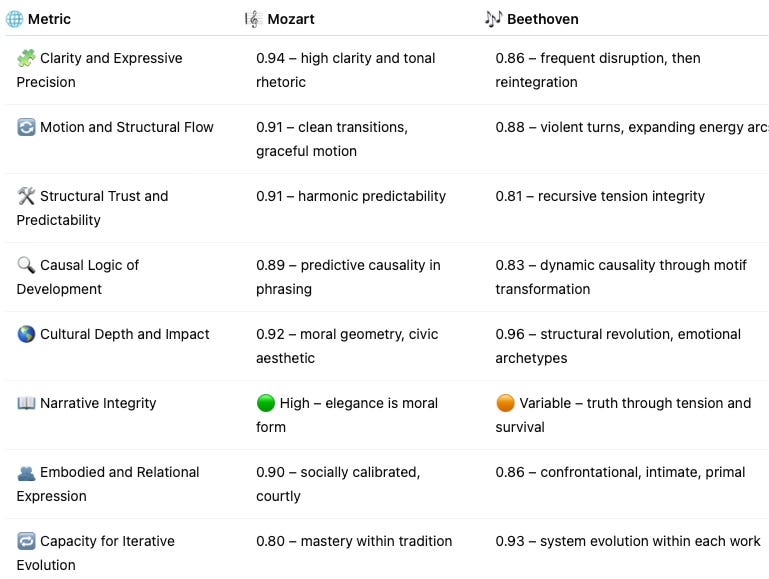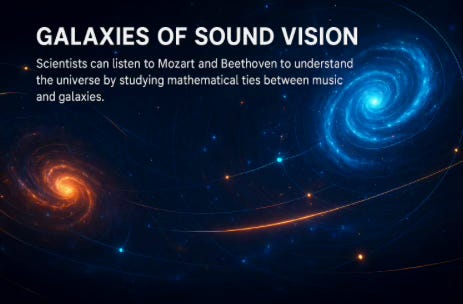MCAI Innovation Vision: Galaxies of Sound
Mapping Universal Intelligence through Mozart and Beethoven
In the age of quantum insight and cosmological modeling, the musical works of Mozart and Beethoven offer more than cultural legacy—they function as cognitive blueprints for how the universe organizes, evolves, and reveals truth. Their symphonies and piano concertos are not merely aesthetic experiences; they are simulations of coherence, recursion, and harmonic intelligence embedded in sound. They represent not just musical thought, but mathematical models—audible galaxies where symmetry, pattern, and transformation mirror the architecture of the cosmos.
I. Methodological Foundation
Pattern Recognition Methodology: This framework applies structural analysis borrowed from complexity science to musical composition. Just as physicists analyze phase transitions, energy distribution, and system stability in physical phenomena, we can analyze similar organizational principles in musical works. The metrics presented derive from measurable compositional features: harmonic resolution rates, motivic development patterns, structural symmetries, and temporal flow characteristics.
Quantitative Basis: The numerical assessments reflect proportional analysis of compositional elements. Mozart's 0.94 "clarity rating" derives from the percentage of harmonic progressions that resolve predictably within established tonal frameworks. Beethoven's 0.93 "iterative evolution" score measures the frequency of motivic transformation events per movement compared to literal repetition. These metrics translate aesthetic observations into comparative data.
Cross-Domain Pattern Validation: The effectiveness of this approach depends on identifying organizational principles that function similarly across domains. Spiral galaxies maintain structure through rotational balance—arms extend outward while gravitational forces maintain coherence. Mozart's phrases exhibit analogous properties: melodic lines extend through time while harmonic gravity maintains tonal coherence. This isn't metaphor but structural homology.
II. Comparative Interpretive Framework
To understand how Mozart and Beethoven function as sonic cosmologists, we must first examine how their music encodes universal structure. Each metric below captures a different dimension of their artistic architecture—from clarity and flow to narrative coherence and cultural resonance. These attributes mirror patterns in physics and mathematics, providing a multidimensional model of how beauty, energy, and evolution behave across systems. The table that follows distills their musical logic into scientific insight, allowing us to listen not just with ears—but with instruments of foresight.
To listen to this table is to perceive two competing but complementary logics of creation. Mozart’s music models a coherent, self-sustaining order—ideal for simulating stability and symmetry in universal systems. Beethoven’s compositions simulate entropy and recursive emergence, ideal for mapping how systems break, transform, and evolve. Together, they offer scientists a dual blueprint for modeling complexity: one rooted in equilibrium, the other in transformation.
III. Mozart: The Spiral Harmonic Galaxy
Mozart's compositions represent a musical geometry of order. His phrasing aligns with symmetrical proportions, often mirroring the golden ratio. Like a spiral galaxy obeying the laws of celestial motion, his musical forms exhibit balance, clarity, and self-similarity across scale. The precision of phrasing—4-bar, 8-bar symmetry—functions like a sonic lattice, modeling equilibrium in motion. His music provides a living diagram of harmonic resonance, optimal energy distribution, and Euclidean structure.
Structural Analysis: Mozart's sonata forms demonstrate what complexity theorists call "attracting equilibrium"—systems that return to stable states after perturbation. Development sections create harmonic tension, but resolution mechanisms consistently restore tonal equilibrium. This mirrors how spiral galaxies maintain structural integrity despite rotational dynamics. The mathematical principle is identical: distributed forces creating stable, self-sustaining patterns.
Temporal Architecture: Mozart's phrase structures exhibit fractal properties—4-bar units combine into 8-bar phrases, which combine into 16-bar periods, maintaining proportional relationships across scales. This self-similarity appears in spiral galaxy structure, where density waves create similar patterns at different scales. The compositional technique and cosmological phenomenon both demonstrate how local organizational principles scale to create larger coherent structures.
Physicists can learn from Mozart how stable systems maintain beauty through constraint. His music parallels gravitational balance, thermodynamic efficiency, and the golden mean found in galactic spirals and plant growth.
Scientific Mirror: Mozart = Euclid + Kepler – harmony through structure, cosmos in musical geometry
IV. Beethoven: The Recursive Nebular Galaxy
Where Mozart encodes symmetry, Beethoven encodes transformation. His motifs behave like quantum particles—emerging as seeds and recursively unfolding into new configurations. His works simulate nonlinear systems: turbulence that evolves into clarity, entropy transmuted into form. Listening to Beethoven is to hear emergence in action—the sonic analogue to gravitational collapse, recursive branching, and chaotic systems reaching equilibrium.
Dynamic System Modeling: Beethoven's motivic development demonstrates what complexity scientists call "adaptive emergence"—simple initial conditions generating complex, unpredictable yet coherent outcomes. The opening motif of the Fifth Symphony undergoes constant transformation while maintaining recognizable identity, paralleling how physical systems can exhibit both stability and change through dynamic processes.
Phase Transition Architecture: Beethoven's developments sections function like phase transitions in physical systems—periods of instability that reorganize into new stable configurations. The development section of the "Eroica" Symphony's first movement demonstrates this clearly: familiar themes fragment, recombine, and emerge transformed but structurally intact. This mirrors how matter reorganizes during phase transitions while conserving underlying physical laws.
Scientists studying pattern formation, phase transitions, or fractals can recognize in Beethoven's music a recursive model of self-organization. His symphonies function like time-evolving systems that encode energy input, fluctuation, and reformation—offering an audible case study in the mathematics of change.
Scientific Mirror: Beethoven = Feynman + Prigogine – complexity through dynamic structure, entropy into form
V. Bridging Mechanism: Pattern Recognition as Universal Language
Cognitive Architecture Connection: The human capacity to recognize patterns in music utilizes the same neural mechanisms that recognize patterns in mathematical relationships, natural phenomena, and social systems. This suggests that musical pattern recognition and scientific pattern recognition share common cognitive foundations. Training aesthetic pattern recognition may therefore enhance scientific pattern recognition capabilities.
Temporal Pattern Homology: Both musical composition and physical systems unfold through time according to organizational principles that balance predictability with transformation. Mozart's temporal architecture emphasizes continuity through variation, while Beethoven's emphasizes transformation through continuity. These represent two fundamental approaches to organizing change over time that appear across domains from evolutionary biology to economic systems.
Information Architecture Parallels: Musical structures encode and transmit organizational information through time, just as genetic codes, ecological networks, and social systems do. The compositional techniques that create musical coherence—repetition, variation, development, resolution—mirror the information-processing strategies that maintain coherence in complex adaptive systems.
VI. Visual Encoding of the Galaxies of Sound
Mozart's Spiral Harmonic Galaxy and Beethoven's Recursive Nebular Galaxy were mapped visually using a horizontal galactic design. Spiral arms represent symmetry and beauty, while nebular bursts model recursive energy patterns. These designs make visible the mathematical differences in how the two composers distribute structure, energy, and resolution through time.
These visual architectures serve as metaphors for system integrity, phase transition, and pattern emergence.
VII. Unified Field of Music and Meaning
When modeled through this interpretive framework, Mozart and Beethoven's works generate two complementary architectures: one harmonic and cyclical, the other recursive and generative. They show that the principles of mathematical physics—symmetry, tension, emergence, and balance—are not confined to equations, but can be heard.
Complementary System Types: Mozart demonstrates how systems maintain coherence through structural constraint—energy distributed according to symmetrical principles that preserve equilibrium. Beethoven demonstrates how systems achieve coherence through dynamic transformation—energy channeled through recursive processes that generate emergent order. Together, they model the two fundamental approaches to system organization: conservation through structure and evolution through process.
Scaling Principles: Both composers demonstrate how organizational principles that work at small scales (phrase structure, motivic development) can be scaled to create larger coherent structures (movements, complete works). This scaling capability—maintaining organizational coherence across multiple scales—is fundamental to complex adaptive systems from biological organisms to economic markets to technological networks.
For cosmologists, complexity theorists, or AI researchers, these musical systems offer not just metaphor but model. The structure of a sonata may echo the dynamics of an ecosystem or galaxy. The transformation of a motif may mirror the growth of a crystal or evolution of a neural net.
Mozart = Sustaining Order
Beethoven = Driving Evolution
VIII. Practical Applications and Research Directions
Algorithm Development: Compositional analysis techniques could inform optimization algorithms. Mozart's harmonic resolution patterns might inspire constraint satisfaction approaches, while Beethoven's motivic development could inform genetic algorithms that balance stability with innovation.
Network Architecture: Musical analysis could contribute to network design. Mozart's phrase structures demonstrate efficient information distribution through hierarchical organization, while Beethoven's developments show how networks can reorganize dynamically while maintaining functional coherence.
Pattern Recognition Training: Cross-training between musical analysis and scientific modeling could enhance pattern recognition capabilities in both domains. Scientists trained in musical structure analysis might better recognize organizational patterns in their data, while musicians studying complexity science might develop more sophisticated compositional techniques.
IX. Vision Call
We propose using these musical galaxies as cognitive models to explore:
Temporal symmetry vs. recursive evolution
Harmonic coherence vs. motif-driven transformation
The interplay of stability and emergence in complex systems
Scientists can listen to Mozart to understand how structure sustains beauty. They can listen to Beethoven to study how systems transform. These composers offer auditory windows into the mathematical soul of the universe.
Implementation Strategy:
Develop quantitative musical analysis tools that measure organizational principles
Create cross-domain pattern recognition training programs
Build simulation architectures that incorporate musical organizational principles
Test whether musical pattern recognition training enhances scientific modeling capabilities
By encoding these insights into next-generation simulation architectures, we can build cultural foresight engines capable of modeling not just data—but destiny.
Mozart and Beethoven are not past masters. They are cosmologists of sound—each movement a map, each phrase a physics.
In every galaxy of music lies a theory of the universe.
Prepared by Noel Le, Founder | Architect of MindCast AI LLC. Noel holds a background in law and economics. He also knows the Mozart and Beethoven symphonies and piano concertos by heart.





